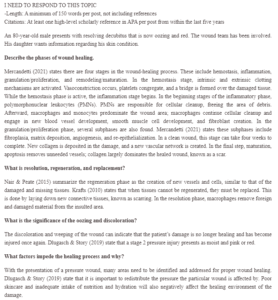Wound Healing
Travis,
Thank you for sharing your post. I am impressed by the detailed description in your post. Since you have covered most of the ground, I will only add a few elements. Wound healing involves four stages that undergo complex interactions between the cells. In simpler language, the stages of recovery involve prevention of excessive blood loss, defense, cleaning of the wound, and repairing/healing. The first step is known as homeostasis, which leads to clotting if the blood is well-balanced. This promotes healing through scab formation, which closes up the wound. The clotting process depends on fibrin and platelets. Macrophages facilitate the cleaning process. During the rebuilding stage, injuries may appear swollen and reddish. These aspects subside with time. The body encourages strengthening even after the damage has closed up (Healthline Media, a Red Ventures Company, 2021). Various factors such as diabetes, obesity, high blood pressure, and vascular conditions may delay or negatively affect the process of wound healing. Oozing from a wound can signify infections by various bacteria. Healing ulcers bleed serous discharge, while infected ulcers ooze purulent discharge. Plus, which can be yellowish or creamish, shows a staphylococcal infection. A shot that is bloody and opaque shows a streptococcal disease. The green release is common in Pseudomonas ulcers. It is important to pay attention to the wound’s progression to avoid sepsis (Iqbal et al., 2017). Our assignment help will hone your writing prowess for papers that will awe your professors.
References
Healthline Media is a Red Ventures Company. (2021). What to Expect During the 4 Stages of Wound Healing.
Iqbal, A. (2017). Management of Chronic Non-healing Wounds by Hirudotherapy. World Journal of Plastic Surgery, 6(1), 9-17.
ORDER A PLAGIARISM-FREE PAPER HERE
We’ll write everything from scratch
Question
I NEED TO RESPOND TO THIS TOPIC
-Length: A minimum of 150 words per post, not including references
Citations: At least one high-level scholarly reference in APA per post from within the last five years

Wound Healing
An 80-year-old male presents with resolving decubitus that is now oozing and red. The wound team has been involved. His daughter wants information regarding his skin condition.
Describe the phases of wound healing.
Mercandetti (2021) states there are four stages in the wound-healing process. These include hemostasis, inflammation, granulation/proliferation, and remodeling/maturation. In the hemostasis stage, intrinsic and extrinsic clotting mechanisms are activated. Vasoconstriction occurs, platelets congregate, and a bridge is formed over the damaged tissue. While the hemostasis phase is active, the inflammation stage begins. In the beginning stages of the inflammatory phase, polymorphonuclear leukocytes (PMNs). PMNs are responsible for cellular cleanup, freeing the area of debris. Afterward, macrophages and monocytes predominate the wound area; macrophages continue cellular cleanup and engage in new blood vessel development, smooth muscle cell development, and fibroblast creation. In the granulation/proliferation phase, several subphases are also found. Mercandetti (2021) states these subphases include fibroplasia, matrix deposition, angiogenesis, and re-epithelialization. In a clean wound, this stage can take four weeks to complete. New collagen is deposited in the damage, and a new vascular network is created. In the final step, maturation, apoptosis removes unneeded vessels; collagen largely dominates the healed wound, known as a scar.
What is resolution, regeneration, and replacement?
Nair & Peate (2015) summarize the regeneration phase as the creation of new vessels and cells, similar to that of the damaged and missing tissues. Krafts (2010) states that when tissues cannot be regenerated, they must be replaced. This is done by laying down new connective tissues, known as scarring. In the resolution phase, macrophages remove foreign and damaged material from the insulted area.
What is the significance of the oozing and discoloration?
The discoloration and weeping of the wound can indicate that the patient’s damage is no longer healing and has become injured once again. Dlugasch & Story (2019) state that a stage 2 pressure injury presents as moist and pink or red.
What factors impede the healing process and why?
With the presentation of a pressure wound, many areas need to be identified and addressed for proper wound healing. Dlugasch & Story (2019) state that it is important to redistribute the pressure the particular wound is affected by. Poor skincare and inadequate intake of nutrition and hydration will also negatively affect the healing environment of the damage.
References
Dlugasch, L., & Story, L. (2019). Applied pathophysiology for the advanced practice nurse (1st ed.). Jones & Bartlett Learning.
Krafts, K. P. (2010). Tissue repair: The hidden drama. Organogenesis, 6(4), 225-233.
Mercandetti, M., MD. (2021). Wound Healing and Repair. Retrieved from https://emedicine.medscape.com/article/1298129-overview#showall
Nair, M., & Peate, I. (2015). Pathophysiology for Nurses at a Glance. John Wiley & Sons.
Wallace, H. A., Basehore, B. M., & Zito, P. M. (2017). Wound healing phases.

